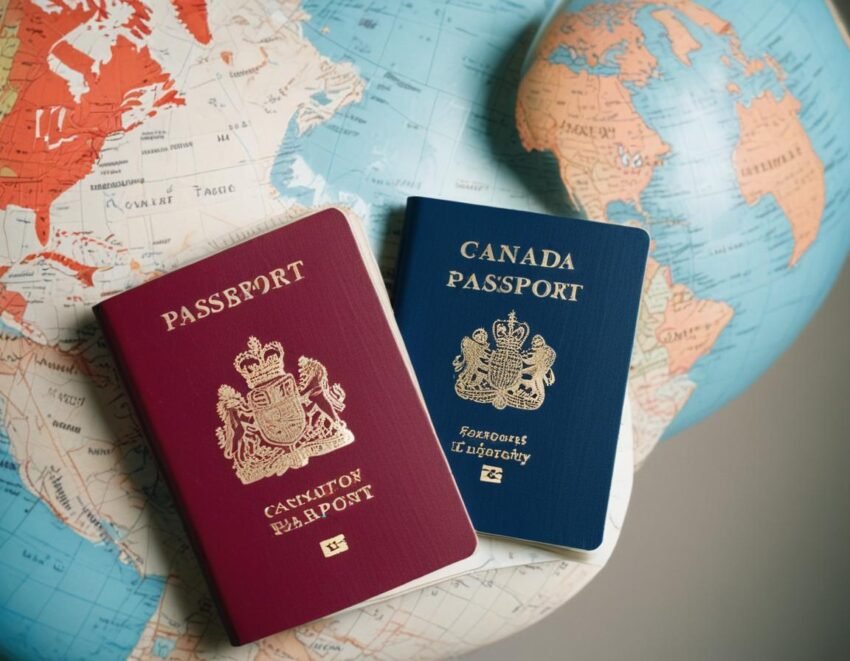Travel Trends
How Canada Passport Power Surpasses US in Global Mobility Rankings, Here is New Travel Trend along with Where Canadians Travelling Right Now

Friday, July 25, 2025
In 2025, Canada’s passport power has surpassed the U.S. in the global mobility rankings, highlighting a shift in how Canadians are now able to travel the world. With Canada now holding an impressive position in the Henley Passport Index, its passport grants visa-free access to 184 countries, outshining the U.S. passport, which now ranks behind.
This development has led to a new travel trend, where Canadians are exploring more international destinations that offer easy entry. As Canada’s passport strength continues to grow, Canadians are increasingly choosing destinations that align with their preference for seamless travel and effortless access.
From Asia to Europe, Canadians are enjoying greater mobility, making travel more convenient than ever. In this report, we explore how Canada’s passport has shifted the global travel landscape and where Canadians are heading in 2025 to take full advantage of this newfound travel freedom.
In a landmark shift in global travel rankings, the Canadian passport has overtaken the U.S. passport, securing a higher position in the 2025 Henley Passport Index. This year, Canada’s passport ranks 8th, while the U.S. follows in 10th place—a noticeable change that signals the evolving travel landscape and reflects the political and economic factors shaping how citizens from both countries experience international mobility.
The global passport ranking, released by Henley & Partners, evaluates the visa-free access passport holders have to countries around the world, including both visa on arrival and electronic travel authorization (ETA) access. The results are striking, as Canada’s passport now grants access to 184 countries without the need for a visa, ahead of the U.S., which can access only 183 countries without the same requirements.
This milestone for Canada comes amid growing global concerns, including ongoing trade tariffs and political friction between the two North American neighbors, which have had a noticeable impact on travel trends. While Canada’s passport retains a high mobility score, the U.S. passport has been slipping in recent years due to stagnant progress and shifting geopolitical dynamics.
The Rise of the Canadian Passport: A Reflection of Changing Travel Trends
Canada’s high mobility ranking is more than just a number—it’s an indication of how the country is positioned globally in terms of trust, stability, and political relationships. According to experts, Canada’s reputation for safety, prosperity, and commitment to welcoming visitors has played a significant role in its rising passport strength. As countries increasingly place high value on reciprocity and bilateral visa agreements, Canada’s passport has benefitted from this approach, especially as global travelers become more discerning about where they can travel freely.
One significant factor contributing to the Canadian passport’s rise is its strong diplomatic relationships across a diverse range of nations. For instance, Canada benefits from favorable visa agreements with key international players in Europe, Asia, and Latin America—which gives Canadian citizens the ability to enter numerous countries with ease. The index’s ranking methodology evaluates visa requirements, government approval for travel, and pre-departure approvals, allowing countries with stable diplomatic relations to score higher in mobility.
While Canada’s passport continues to enjoy high mobility, its U.S. counterpart has seen a decline in its global standing in recent years. The U.S. passport was once ranked number one globally, but it has gradually lost ground. Since 2014, the U.S. has gained access to only eight additional destinations, while other nations like Japan and Singapore have surged ahead. These changes reflect broader geopolitical shifts, including trade disputes, visa changes, and administrative challenges that have contributed to a slowdown in international travel agreements for the U.S.
Impact of Tariffs and Political Tensions on U.S.-Canada Travel
One of the most significant drivers of this shift is the growing political tension between the U.S. and Canada, particularly after the imposition of tariffs on Canadian goods. In response to these tariffs, many Canadians have become increasingly reluctant to travel south, and some are turning to domestic travel or visiting countries with more favorable relations. The “Buy Canadian” movement has gained momentum, with more citizens opting to explore local destinations rather than spending money on cross-border travel to the U.S.
Experts suggest that Canada’s political stability and its economically prosperous environment play a key role in fostering mutual trust with other countries, enabling Canadians to travel freely across most of the globe. Conversely, the U.S. passport has faced difficulties due to the country’s controversial policies on visa issuance and border security. These challenges have made Canada a more attractive option for travelers seeking visa-free access to global destinations.
Why Canada’s Passport is Gaining Strength
Canada’s passport has traditionally ranked among the top ten passports globally, and its high ranking has remained consistent for several years. However, in recent times, a combination of factors has contributed to the passport’s climb in the rankings. These factors include the growth of Canada’s global standing, its commitment to international agreements, and its safety and prosperity. Additionally, Canada’s inclusive approach to immigration and its reputation as a peaceful nation with a robust legal framework for international relations has created an environment where Canadian citizens are more likely to be welcomed around the world.
Another important factor influencing this shift is Canada’s increasing involvement in global peacekeeping efforts and international trade agreements, which has strengthened the country’s diplomatic reach. These international engagements have fostered reciprocal agreements with several key travel partners, allowing Canadian passport holders to benefit from easy access to destinations previously restricted.
Canada’s 2025 Passport Overhaul: A New Era of Efficiency and Security for Travelers
In a major move to improve passport services, Canada has introduced a series of significant updates to its passport system, aimed at enhancing efficiency, security, and accessibility for Canadian citizens. These changes reflect the Canadian government’s commitment to adapting to the evolving needs of travelers while ensuring that Canadian travel documentation remains secure and modern in an increasingly globalized world.
The new passport rules, which were unveiled in 2025, are designed to address the challenges Canadians face when applying for or renewing their passports. With faster processing times, expanded online services, and improved design features, these updates will significantly impact how Canadians travel both domestically and internationally.
Updates in Canada’s Passport System: What’s New in 2025?
The 2025 updates to Canada’s passport system are comprehensive, affecting several areas of passport management, including processing times, renewal services, and security features.
A standout feature of the updated system is the new processing time guarantee. Starting March 7, 2025, all complete passport applications will be processed within 30 business days. This is a significant improvement, as Canadians have long expressed frustration with the lengthy waiting times, particularly during peak travel seasons. This service guarantee ensures a faster and more reliable experience, and if the processing time exceeds the 30-day period, applicants will be eligible for a full refund of their passport fees, providing peace of mind for travelers who rely on timely documentation.
The Expansion of Online Passport Renewal Services
As part of Canada’s ongoing efforts to modernize government services, online passport renewal has been significantly expanded. Previously, online renewals were only available to a limited number of adult citizens, typically those with unexpired passports in good condition. However, in 2025, more Canadians will be eligible for online renewals, making it more convenient to apply for passport updates from the comfort of their homes.
This expansion will save both time and effort for those living far from passport offices or with busy schedules. With the online renewal system, Canadians can complete their passport renewal applications online, upload necessary documents, and receive their updated passports by mail without needing to visit a Service Canada location. This move is in line with Canada’s broader push to digitize government services and make them more accessible to the public.
Enhanced Passport Security: New Design Features and Anti-Counterfeiting Measures
In addition to streamlining services, the updated Canadian passport features a new design aimed at enhancing both aesthetics and security. Launched in 2023, the updated passport design includes several advanced security features designed to prevent counterfeiting and protect travelers’ identities. These features include:
- Microprinting and holographic images, which are difficult to replicate.
- UV-visible printing and intricate watermarks, which further bolster security.
- Updated aesthetic design, featuring images of iconic Canadian landmarks and historical figures that celebrate the nation’s multicultural identity.
The new design ensures that the Canadian passport not only remains highly secure but also visually reflects the country’s diverse and modern identity. The inclusion of cultural symbols and national icons helps make the passport more appealing, particularly to a younger generation of travelers.
While the updated design has been well received, some Canadians have expressed concerns over the removal of traditional symbols that were previously included in the passport. However, the overall design updates align with Canada’s evolving identity, aiming to create a passport that resonates with a broad spectrum of the population.
Passport Validity and Entry Requirements: What Travelers Need to Know
Canada continues to offer two types of passports: the 5-year passport and the 10-year passport. The 5-year passport costs CAD $120, while the 10-year passport is priced at CAD $160. This pricing structure provides flexibility, allowing Canadian travelers to choose the passport duration that best suits their travel plans.
It is important for travelers to keep in mind that certain countries require passports to be valid for six months beyond the date of entry. Even if a passport has several months left before it expires, it may not be accepted for travel to some international destinations. Canadian travelers should always check the entry requirements of their destination country to ensure that their passport meets the validity criteria.
One noteworthy provision applies to dual U.S.-Canadian citizens. While U.S. passport holders can use their U.S. passports for travel between Canada and the United States, Canadian citizens must present a valid Canadian passport when returning to Canada. This regulation simplifies entry procedures and ensures that travelers have the proper documentation when crossing international borders.
U.S. Passport Decline: How Geopolitical Shifts Have Impacted Global Travel
While Canada’s passport is on the rise, the U.S. passport has seen a notable decline in its global ranking. Once the world’s most powerful passport, the U.S. has now fallen to 10th place in the Henley Passport Index, a slip that underscores a significant shift in global travel patterns. The U.S. passport has not made significant gains in recent years, with only eight additional destinations added to its list of accessible countries since 2014.
Several factors have contributed to this decline. The current U.S. administration’s approach to international relations, especially in terms of visa policies and trade tariffs, has created friction with countries that were once favorable travel partners. These diplomatic tensions, coupled with stricter visa requirements for travelers from certain regions, have caused the U.S. to lose its previous standing as the global leader in travel accessibility.
Additionally, the visa approval process in the U.S. has become more cumbersome, leading to longer wait times for travelers and reducing the appeal of the U.S. as a travel destination for international visitors. In contrast, countries like Japan, Singapore, and Canada have gained in mobility, largely due to efficient diplomatic strategies and visa agreements with a wide range of countries.
The Future of U.S. and Canadian Travel
Looking ahead, the U.S. and Canada will continue to be key players in the global travel market, though their travel dynamics may evolve. For Canadian travelers, the ability to visit 184 countries without the need for a visa places the country in an advantageous position, and this could continue to influence the way Canadians approach international travel. The shift toward domestic tourism, driven by the ongoing trade tensions, may continue, but Canadian travelers will still enjoy significant access to global destinations due to the strength of their passport.
For U.S. travelers, the challenges of visa requirements and diplomatic tensions with other countries may persist, but it remains to be seen how U.S. policy changes under future leadership will affect passport rankings. Ultimately, both countries will need to address their diplomatic and economic relationships to ensure that their passports maintain strong global mobility.
Canada’s Passport Overtakes the U.S. in 2025 Henley Passport Index
In a landmark shift in global travel rankings, Canada’s passport has officially surpassed the United States in the 2025 Henley Passport Index, cementing its position as one of the most powerful passports in the world. The Henley Passport Index, compiled annually by Henley & Partners, ranks countries based on the number of destinations their citizens can access without a visa or with visa-on-arrival access. This year, Canada’s passport ranks in 8th place, while the U.S. is down to 10th place, a dramatic shift from its previous dominance.
The rise of Canada’s passport and the subsequent decline of the U.S. passport are reflective of several geopolitical factors, diplomatic relations, and global mobility trends that are reshaping the travel landscape. These changes underscore the evolving nature of international travel and the impact of policy decisions, trade relations, and visa agreements on passport rankings.
The Canadian Passport: A Growing Symbol of Mobility and Global Trust
Canada’s rise to 8th place in the Henley Passport Index reflects its strong global standing and its ability to maintain favorable visa agreements with key nations. Canadian passport holders can now access 184 countries without the need for a visa, outpacing the U.S., which offers access to 183 destinations. The Canadian passport’s increasing mobility is a direct result of the country’s stable diplomatic relationships and proactive engagement with other nations to secure visa waivers and reciprocal travel agreements.
Experts attribute Canada’s rise in global mobility to the country’s commitment to peacekeeping, international trade agreements, and its overall reputation for safety and prosperity. Canada’s passport strength is further bolstered by its inclusive immigration policies and the trust other countries place in Canadian citizens. As global travel continues to evolve, Canada’s ability to forge reciprocal visa agreements and foster strong international relations has made it a more attractive travel partner on the global stage.
The Decline of the U.S. Passport: A Result of Geopolitical Shifts
While Canada’s passport is on the rise, the U.S. has seen a decline in its global standing in recent years. Once the world’s most powerful passport, the U.S. has now dropped to 10th place in the Henley Passport Index, primarily due to strained diplomatic relations and policy decisions that have affected its ability to secure visa waivers and travel agreements with key countries.
The U.S. passport’s decline can be attributed to several factors, including the visa restrictions imposed by the U.S. government and trade disputes with nations that were once easy destinations for U.S. travelers. The current U.S. administration’s policies, particularly concerning immigration and border security, have led to increased visa requirements and a less favorable perception of the U.S. abroad. This has directly impacted the U.S. passport’s mobility, as fewer countries are willing to grant visa-free access to American citizens.
Since 2014, the U.S. passport has only gained access to eight additional destinations, while countries like Japan and Singapore have seen significant increases in visa-free access, pushing them ahead in the rankings. The U.S. has fallen from 1st place in 2014 to 10th place in 2025, a noticeable drop that highlights the shifting global dynamics in travel accessibility.
The Shifting Global Landscape: How Political and Economic Factors Shape Passport Strength
The Henley Passport Index is not just a measure of passport strength; it’s a reflection of global relations and how countries interact on the world stage. Diplomatic agreements, international trade, and visa policies all play a significant role in shaping the accessibility of a country’s passport. In Canada’s case, its stable international relations, peacekeeping efforts, and economic prosperity have contributed to its strong global mobility.
On the other hand, the U.S. passport’s decline highlights the impact of national policies on global travel. With visa restrictions, trade tariffs, and increased border security, the U.S. has become less attractive for other countries to engage with diplomatically, which in turn affects the U.S. passport’s global standing.
As the global mobility index becomes more important for countries seeking to attract tourists, business travelers, and global talent, the rise of Canada and the decline of the U.S. show how diplomatic and policy shifts can dramatically influence a country’s passport power. This trend will likely continue as global dynamics evolve, with countries like Japan, Singapore, and South Korea leading the way in visa-free travel access.
The Growing Importance of Canada’s Global Mobility and What It Means for Travelers
For Canadian travelers, the rise in passport strength means greater travel freedom and ease of access to destinations around the world. With 184 countries now accessible without the need for a visa, Canadian passport holders enjoy significant advantages when it comes to international travel. Whether it’s tourism, business, or education, the Canadian passport offers increased flexibility and convenience when it comes to planning international trips.
For U.S. travelers, the decline in passport strength may mean more hassle when applying for visas or entering certain countries. Travelers from the U.S. may need to plan further in advance and apply for visas or e-Visas to visit previously visa-free destinations. The decline of U.S. passport mobility also underscores the importance of global relationships and the role that diplomatic relations play in shaping international travel.
The Future of Global Mobility: What’s Next for the U.S. and Canada?
Looking forward, the U.S. passport faces challenges in maintaining its position in the global mobility rankings. The U.S. government will need to reassess its foreign policy and visa strategies to improve relationships with other countries and ensure that its citizens continue to enjoy easy access to global destinations. As countries around the world continue to prioritize reciprocal visa agreements and global cooperation, the U.S. may need to adapt its approach to diplomacy to regain its competitive advantage in the passport rankings.
For Canada, the future looks promising. With its high global mobility and continued diplomatic engagement, the Canadian passport is likely to remain a powerful travel document in the years to come. Canada’s efforts to expand its international relationships, particularly through free trade agreements and multilateral cooperation, will continue to support its passport’s strength and open new doors for Canadian travelers.
Canada’s Passport Leads the Way in 2025, but Challenges Persist for the U.S.
The 2025 Henley Passport Index underscores the shifting dynamics of global travel and the impact of political decisions on passport strength. Canada’s rise to 8th place and the U.S. passport’s decline highlight the importance of global diplomacy, visa policies, and international agreements in shaping travel opportunities. While Canada continues to lead with 184 destinations available visa-free, the U.S. passport faces an uphill battle to maintain its standing as the global leader in mobility.
For Canadian travelers, this means greater access to international destinations, while U.S. citizens may face more restrictions and visa requirements in the future. As the global travel landscape continues to evolve, both Canada and the U.S. must navigate diplomatic challenges and work towards strengthening their passports to ensure global mobility for their citizens in the years ahead.
Canada’s Evolving Travel Habits: A Shift Toward Simplicity and Global Exploration
In 2025, Canadian travelers are embracing a shift in how they approach their vacations. Following the rise in global mobility and the steady strengthening of the Canadian passport, many Canadians are opting to explore international destinations with hassle-free entry policies. Whether it’s visa-free travel or the opportunity to obtain a visa on arrival, the ease of access plays a pivotal role in where Canadians choose to travel this year. As Canada’s passport ranks 8th globally in the Henley Passport Index, its citizens enjoy broad mobility that allows them to explore a variety of countries without the complexities of visa applications.
While domestic tourism has also seen a rise, with more Canadians embracing their local beauty, international travel to countries offering easy entry policies is gaining momentum. From the vibrant streets of Tokyo to the sandy beaches of Thailand, Canadians are venturing out to experience new cultures, adventures, and attractions—without the burden of extensive paperwork. Below, we delve into the most popular destinations Canadian tourists are heading to in 2025 due to the ease of access provided by visa-free policies and streamlined visa procedures.
1. Japan: A Haven for Cultural Enthusiasts and Modern Travelers
In 2025, Japan has become an increasingly popular destination for Canadian travelers. The country has been a staple in the global tourism scene due to its seamless visa-free access for Canadian citizens, allowing them to stay for up to 90 days. As one of the most sophisticated countries in Asia, Japan offers an unmatched blend of ancient culture and modern innovation.
Tourists can explore the bustling metropolis of Tokyo, where towering skyscrapers and vibrant nightlife coexist with centuries-old temples and traditional tea ceremonies. For those looking for a more serene experience, Kyoto’s iconic Bamboo Forest and tranquil Kinkaku-ji (Golden Pavilion) provide a calming retreat. The natural beauty of Mount Fuji offers hikers and nature lovers a scenic and rewarding experience. Japanese culture, which emphasizes the blend of past and present, is one of the main reasons why Canadians are flocking to this fascinating country.
2. Thailand: The Land of Smiles Beckons Canadian Travelers
Thailand remains a top destination for Canadian tourists in 2025, and for good reason. As a country with visa-free access for Canadians, Thailand offers effortless travel to explore its tropical islands, cultural landmarks, and bustling cities. Known as the “Land of Smiles”, Thailand provides visitors with warm hospitality and diverse landscapes, from stunning beaches to historic temples.
Bangkok, the vibrant capital, offers everything from grand palaces to bustling markets. For those seeking peace and tranquility, the islands of Phuket and Koh Samui are perfect destinations for relaxation. Chiang Mai, located in the northern part of the country, is known for its traditional temples and mountain scenery, making it an ideal destination for cultural immersion and adventure.
Thailand’s affordable travel options and easy visa policies continue to attract Canadians seeking adventure, relaxation, and cultural enrichment. With an abundance of street food, colorful festivals, and scenic landscapes, it is no surprise that Thailand remains a favorite among Canadian travelers.
3. United Arab Emirates (UAE): Luxury Meets Culture in Dubai and Abu Dhabi
In 2025, the United Arab Emirates (UAE) is a rising star in Canadian tourism, largely due to the visa-free access for Canadian passport holders. This gateway to luxury offers Canadians an unparalleled experience of modern cities, luxurious resorts, and a fusion of traditional Arabian culture and cutting-edge technology.
The towering skyscrapers and opulent shopping malls of Dubai captivate tourists looking for a blend of contemporary luxury. Burj Khalifa, the world’s tallest building, offers breathtaking views of the city’s skyline. Abu Dhabi, the capital, is home to the stunning Sheikh Zayed Grand Mosque and the Louvre Abu Dhabi, providing a fascinating mix of modern art and rich history.
Additionally, the UAE’s year-round sunny weather, luxurious beaches, and indoor ski slopes make it an ideal destination for Canadians seeking both relaxation and adventure. The seamless entry process and world-class amenities continue to draw Canadians to this destination.
4. South Korea: A Dynamic Destination for History, Nature, and Innovation
With a strong cultural appeal and visa-free entry, South Korea is another key destination for Canadian tourists in 2025. Known for its advanced technology, rich cultural history, and spectacular landscapes, South Korea offers a well-rounded travel experience that appeals to all types of travelers.
The bustling capital, Seoul, features a mixture of high-tech modernity and traditional heritage, with attractions like Gyeongbokgung Palace, Bukchon Hanok Village, and cutting-edge shopping districts like Myeongdong. Nature lovers can explore Jeju Island, renowned for its volcanic landscapes, gorges, and waterfalls, while ski enthusiasts flock to Pyeongchang during the winter months.
South Korea’s easy visa policy, combined with its unique mix of old and new, makes it an ideal destination for Canadians who want to experience both adventure and cultural exploration. The growing number of direct flights from Canada to South Korea adds convenience, making it even easier for Canadians to explore this dynamic country.
5. European Union (Schengen Area): Accessible Travel for Canadians
The European Union (EU) continues to be one of the most popular destinations for Canadians in 2025. While the Schengen Area provides visa-free access to many European countries, this region offers a diverse range of travel experiences, from historic landmarks in Italy to scenic vistas in Switzerland. Canadians can visit up to 26 countries in the Schengen Area without the need for a visa, making it one of the most accessible regions for international travelers.
From Paris’ romantic ambiance to the cultural treasures of Rome and the alpine beauty of Switzerland, Canadians have a wealth of options for exploration in Europe. The EU’s relaxed travel regulations continue to draw Canadians to its rich history, art, architecture, and vibrant local cultures.
6. Indonesia: A Tropical Escape with Easy Access
Indonesia, with its beautiful beaches, cultural richness, and easy visa procedures, remains a top choice for Canadians seeking tropical escapes. The country’s visa-on-arrival policy for Canadian citizens allows visitors to enjoy an unforgettable experience without the stress of applying for visas beforehand.
Indonesia’s most famous destinations, such as Bali, Komodo Island, and Yogyakarta, offer everything from ancient temples to surfing and diving adventures. Whether it’s exploring the UNESCO-listed temples of Borobudur and Prambanan or simply relaxing on the beaches of Bali, Indonesia’s affordable prices and easy entry make it a standout choice for Canadian travelers.
A New Era for Canadian Travelers and U.S. Policy
Canada’s rise in the Henley Passport Index is a direct result of the country’s commitment to global diplomacy, economic stability, and inclusive immigration policies. As Canadian citizens continue to benefit from visa-free access to 184 countries, the U.S. faces growing challenges in maintaining its global travel leadership. As both countries navigate these evolving dynamics, Canadian travelers are poised to enjoy even more seamless access to global destinations, while U.S. citizens may need to adjust to changing international travel norms.
Ultimately, the Canadian passport’s rise reflects broader trends in global travel patterns, with shifting political landscapes and economic considerations playing pivotal roles in shaping the future of international mobility.
Travel Trends
Discover how Nigeria, India, Saudi Arabia, Japan, Spain, and Mexico Leading the Way in Travel Trends for 2025: What’s New To Know?

Sunday, July 27, 2025
With the world slowly reopening to the public after two tough years, travel trends are changing quickly. Countries including Nigeria, India, Saudi Arabia, Japan, Spain and Mexico have been leading the transition. Each of these countries is playing a part in these global travel trends, and it’s proving that what modern tourists want is constantly changing. With the ‘bleisure’ (business-leisure) boom in Nigeria and the immersive cultural experiences being offered in Mexico and Japan, these are the countries cashing in on the travel trends shaping 2020.
Nigeria, in particular, has begun to be noticed by industry analysts. Nigeria has been recognised as a huge reservoir of travel demand by no less a global consulting giant than Boston Consulting Group (BCG). Its cultural depth, religious variety and newfound focus on safety and infrastructure have put it at the intersection of durable tourism trends in 2025. But Nigeria not alone, other nations such as India, Saudi Arabia, Japan, Spain, and Mexico are also bullish with tourism strategies. Collectively, these countries are not just sparking new modes of travel, they’re preparing themselves to be pivotal players in the global $15 trillion leisure travel market of 2040.
Nigeria: Leading the Pack in Bleisure and Safety-Cautious Travel
Nigeria is leading the ‘bleisure’ revolution worldwide, as business travelers extend their itinerary for pleasure. With 73% of Nigerian travelers planning to mix business and leisure on their next trip, according to the BCG survey, Nigerians are leading the trend. This percent is well above one found in countries such as Germany (30%), UK (22%), or the US (15%). This realization therefore puts Nigerian travelers ahead of the tourism career by mixing work and play in ways that give businesses an opportunity to exploit these spaces and make a kill.
The Nigerian travel market is also particularly well adapted to safety-crazy travellers. With growing concerns about health and security, it is perhaps not surprising Nigeria’s recent investments into healthcare infrastructure, coupled with a focus on public safety, are expected to encourage increasing numbers of tourists whose top considerations are safety and wellness. This has been to the country’s benefit because of its rich cultural offering, its religious tourism and growing interest in health and safety, all of which has come to its advantage now, making it an attractive choice for the new “safety-seeking” traveler.
India: A Land of Culture for Spiritual and Heritage Tourism
India has always been a great country for the religious, cultural traveller. Come 2025, the country will still be wowing international travellers with its vibrant culture and increasing emphasis on wellness and sustainable tourism. With more and more travelers looking for an experiential, immersive holiday, India provides a variety of destinations that is unparalleled — whether it’s the ancient temples of Varanasi or the serene backwaters of Kerala.
Tourism in India has evolved to include not only historical sites but also wellness tourism, the likes of yoga retreats, Ayurveda healing and wellness getaways, becoming a key part of travel for both leisure and leisure-oriented business travelers. The Enhancements cater to a great demand for Spiritual and Restorative tourism, placing India at the top in the global market for wellness tourism. What’s more, global and local citizens are getting easier access with Indian government working on infrastructure upgrade and regional tourism promotion.
Luxury and Heritage Tourism Investment in Saudi Arabia
Launching Saudi Arabia’s Vision 2030, the Kingdom of Saudi Arabia has embraced the diverse tourism experiences that the country has to offer and has developed a tourism system and infrastructure that has positioned the Kingdom to attract increasing numbers of international visitors to the land of Saudi”.Generally speaking, Vision 2030 has thrust Saudi Arabia onto the world stage of tourism. With new cultural and entertainment attractions, such as the historic city of Al-Ula, and the Red Sea Project, Saudi Arabia is setting its sights on becoming a can’t-miss destination for the world’s high spending travelers. The Kingdom’s investments in cutting-edge resorts, upscale hotels, cultural festivals – all of it is changing the way you experience the Middle East.
And even while it draws more international tourists to the luxury of its offerings, the country is also marketing a deep dive into its rich history, putting on display ancient archaeological sites that go back thousands of years. This blend of heritage and elegance will attract tourists looking for culture and luxury in equal measures, now showcasing Saudi’s role in the luxury tourism sector.
Japan: A world leader in technology and sustainability
For years, Japan has been known for futuristic technology, but 2025 will also see it become one of the leading ecotourism destinations on our planet. As eco-friendly travel continues to move to the forefront, Japan has paved a path of high-tech experiences that boost efficiency but also decrease the ill effects of tourism on the environment. From AI-guided Japanese travel guides to the robotic concierge services, here are five examples to illustrate how Japan’s tourism tech revolution is redefining custom travel.
Furthermore, Japan’s dedication to sustainable tourism can be seen in its rural eco-tourism, which allows travellers to enjoy a true Japanese experience in the authentic Japanese countryside devoid of traffic and urbania. This increasing focus on decent sustainability and tech-forward travel is drawing an increasing number of eco-conscious travellers to Japan, thereby placing Japan on the forefront of advancing technology and sustainability without stifling cultural development.
Spain in Top 5 for Travelers Seeking Wellness, Cultural and Food Tourism
The country draws millions of tourists each year, who come for its sun, sand, culture and cuisine. Spain is catching up the increasing fashion of wellness tourism, in 2025 traveller can find a variety of wellness retreats and luxury spas specialized on health, relaxation and rejuvenation. Along the Mediterranean coast to the Balearic Islands, Spain’s wellness resorts are gaining worldwide recognition for their emphasis on natural healing, mindfulness and fitness.
And beyond wellness, Spain’s varied cultural offerings — from Andalusia’s flamenco dance to Barcelona’s world-famous architecture — make it a top cultural tourism destination. Spain also is benefiting from a combination of celebrity chefs and culinary innovation, playing into the burgeoning trend of food tourism. The wellness, culture, and food tourism blend positions Spain as a multi-faceted country with something for everyone.SOCKSBOXESCAPPes and culture, foodie tourists and general lovers of wellness making the country a diverse draw.
Mexico: Diving into Immersive Travel and Cultural Spectacles
Mexico is fast becoming a world hub for immersive cultural tourism, giving visitors a chance to dive deep into the country’s rich history, diverse cuisine and local traditions. Its wealth of indigenous culture, combined with world-class beach destinations, make it an attractive destination for travellers who seek adventure alongside cultural experience. This new wave of interest for Mexico’s traditional festivals, such as Día de los Muertos and Carnival, combined with the rise for visitors looking to seek authentic cultural experiences, prepares Mexico to receive new people who are joining this growing global movement.
The nation is also working on developing its eco-tourism sector with several areas already embracing eco-friendly practices to preserve its natural radiance and also provide exciting pledge-filled experiences to tourists. As travellers grow more aware of their impact on the Earth, Mexico’s focus on protecting its rare ecologies while providing responsible tourism leaves it well placed for the future of global tourism.
The Impact on Global Tourism
The travel trends that emerged in countries such as Nigeria, India, Saudi Arabia, Japan, Spain and Mexico, also indicate a significant departure in the way travelers plan vacations. More and more, they are looking for more meaningful experiences, more immersive experiences, and not just to see.” Call it a convergence of business and leisure,an emphasis on health and safety from entering and leaving a destination, cultural and wellness escapades away from the grid or a more meaningful connection to the self and the places they visit, travel experiences are increasingly adopting a more exploratory pace and mindset.
For tourism, these new trends are a chance to tailor their product offerings to what they need to meet the requirements of the modern traveler. As long as these countries keep innovating and building up their tourism infrastructure, they’re not just competing today and preparing for long-term growth; they’re also influencing the future of international travel.
In embracing pleasures such as the bleisure, local culture, well-being and sustainability, they are heralding a new generation of tourism, one that prioritizes experience, safety and togetherness. As global tourism continues to grow in the decades to come, destinations such as Nigeria, India, Saudi Arabia, Japan, Spain and Mexico belong on the leading edge of this exciting transition.
Travel Trends
The Beaumont Mayfair announces September opening of Rosi

This September, The Beaumont Mayfair will embark on an exciting new chapter in the hotel’s culinary story with the launch of Rosi, led by acclaimed chef Lisa Goodwin-Allen, who has been newly appointed as Culinary Director. The opening will bring Modern British dining to the central London neighborhood, and will embrace seasonality and heritage, realized through Chef Lisa’s imaginative style and skilled technique.
Revisiting the classics through a playful lens, Rosi will offer a quintessentially British menu of wit, warmth, and tableside theatre. Signature pies will be inspired by seasonal meats and game, with a year-round serving of Old-Fashioned Pork Pie that will pay homage to traditional British favorites. Other menu highlights include standout cuts of English Wagyu, Lake District beef and heritage Hereford herds, all chosen for their exceptional flavor. Rosi will revive the traditional dining trolley with tableside carvings, serving up pork pie, smoked salmon, beef tartare, and a seasonal sponge. Theatrics on the dessert menu go off the wheels complete with build-your-own sundaes and Chef Lisa’s take on the beloved millionaire’s tart dish.
A feast for the eyes as much as the tastebuds, Rosi will be adorned by eight custom-painted pastel-hued murals portraying vignettes of a bygone era in high society, complemented by a palette of delicate pinks and greens. Whimsical and vibrant, Rosi invites Mayfair locals stopping by for their weekly power lunch, or travelers visiting The Beaumont to an escape in one of London’s most luxurious and historic neighborhoods.

Culinary Director Lisa Goodwin-Allen
Culinary Director Lisa Goodwin-Allen is best known for her work at the prestigious Lancashire darling, Northcote, since just 23 years old, where she helped hold its Michelin Star for over two decades. Lisa will work alongside Executive Chef Brendan Fyldes, and recently appointed Executive Head Chef Jozef Rogulski, who led the kitchen of The Game Bird at The Stafford London for eight years. The concept and team have been brought together by The Beaumont Mayfair’s CEO, Stuart Procter, as part of his ongoing transformation of the hotel since 2024.
“Rosi represents everything we love about British dining; seasonal ingredients, timeless dishes and genuine warmth.” says Stuart Procter. “With Lisa at the helm and Brendan and Jozef by her side, we’re bringing a new energy to The Beaumont and reimagining what dining in Mayfair can feel like.”
Lisa Goodwin-Allen adds, “I can’t wait to open the doors to Rosi, it’s been a joy working with Stuart, Brendan and Jozef to help create my London home. Rosi is a restaurant where the menu is full of dishes you really want to eat, and the atmosphere is just as inviting. I hope Rosi will be embraced by Londoners, just as I have been.”
The article The Beaumont Mayfair announces September opening of Rosi first appeared in TravelDailyNews International.
Travel Trends
Terminal transformation at Kolkata Airport

Netaji Subhas Chandra Bose International (NSCBI) Airport in Kolkata is undergoing a major expansion. The Airports Authority of India plans to demolish the old domestic terminal and replace it with a new U-shaped international terminal. This is in response to rising passenger numbers and the need for increased capacity. The current integrated terminal already handles 26 million passengers annually and is expected to reach its full limit by 2025–26.
Once the new international terminal is completed, the current terminal will be used exclusively for domestic flights. Its capacity will be increased to accommodate 34 million domestic passengers each year. The new international terminal will initially add capacity for 2 million more international travellers, with the possibility of phased expansion in the future. In the meantime, 5,600 square meters are being added to the current terminal to temporarily increase its capacity from 26 to 28 million passengers annually.
The old domestic terminal, constructed in 1995, has been largely unused since 2013 except during emergencies. It served as a COVID-19 quarantine facility and was used for Haj operations. Full demolition of the structure is expected by early 2026, clearing space for the new terminal construction and modern upgrades.
Once the expansion is complete, NSCBI Airport will be able to handle 45 million passengers each year—36 million domestic and 9 million international. The project is part of a broader effort to modernise the airport, improve the travel experience, and support Kolkata’s growing importance as a regional and international hub.
-

 Brand Stories6 days ago
Brand Stories6 days agoBloom Hotels: A Modern Vision of Hospitality Redefining Travel
-

 Brand Stories1 day ago
Brand Stories1 day agoCheQin.ai sets a new standard for hotel booking with its AI capabilities: empowering travellers to bargain, choose the best, and book with clarity.
-

 Destinations & Things To Do7 days ago
Destinations & Things To Do7 days agoUntouched Destinations: Stunning Hidden Gems You Must Visit
-

 AI in Travel7 days ago
AI in Travel7 days agoAI Travel Revolution: Must-Have Guide to the Best Experience
-

 Brand Stories3 weeks ago
Brand Stories3 weeks agoVoice AI Startup ElevenLabs Plans to Add Hubs Around the World
-

 Brand Stories2 weeks ago
Brand Stories2 weeks agoHow Elon Musk’s rogue Grok chatbot became a cautionary AI tale
-

 Destinations & Things To Do1 day ago
Destinations & Things To Do1 day agoThis Hidden Beach in India Glows at Night-But Only in One Secret Season
-

 Asia Travel Pulse3 weeks ago
Asia Travel Pulse3 weeks agoLooking For Adventure In Asia? Here Are 7 Epic Destinations You Need To Experience At Least Once – Zee News
-

 AI in Travel3 weeks ago
AI in Travel3 weeks ago‘Will AI take my job?’ A trip to a Beijing fortune-telling bar to see what lies ahead | China
-

 Brand Stories3 weeks ago
Brand Stories3 weeks agoChatGPT — the last of the great romantics















You must be logged in to post a comment Login